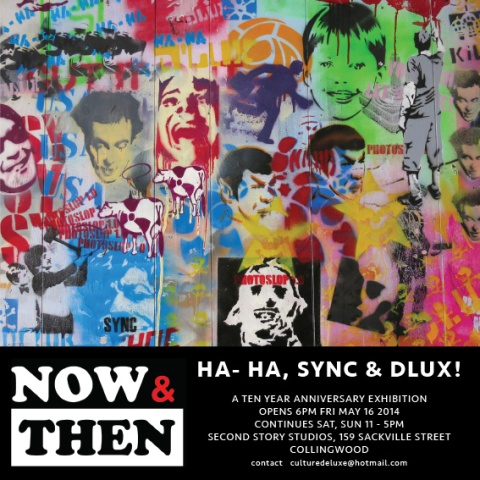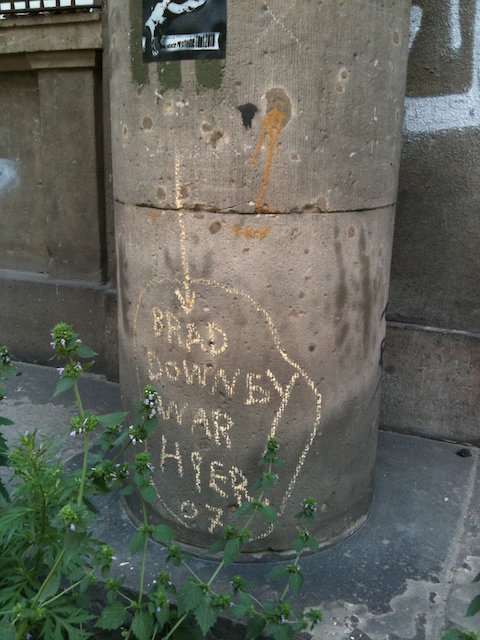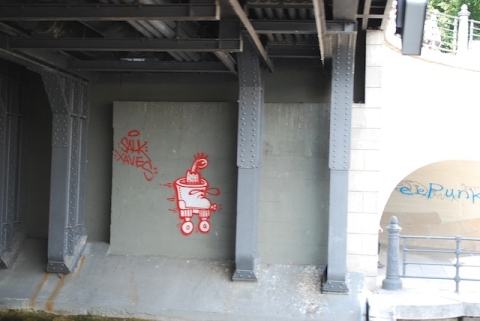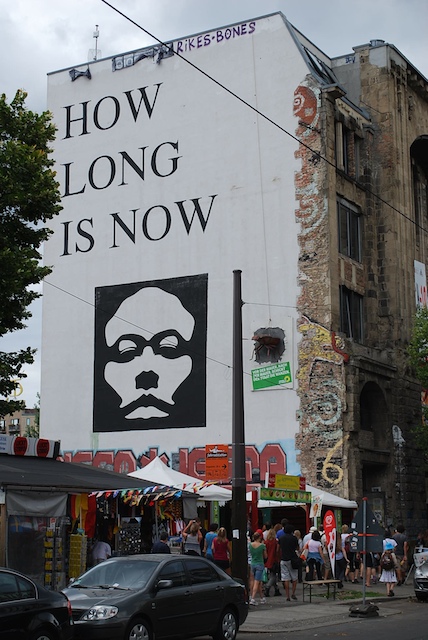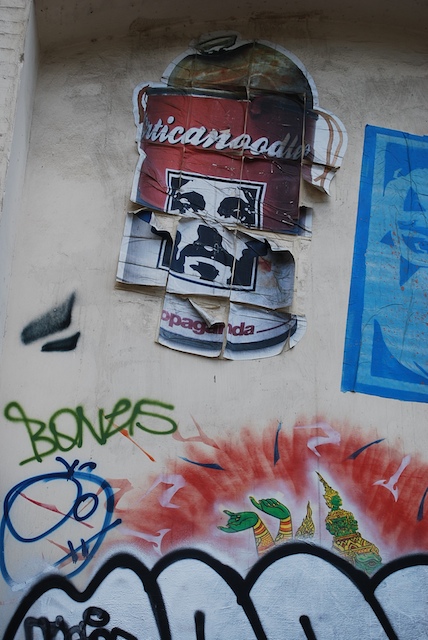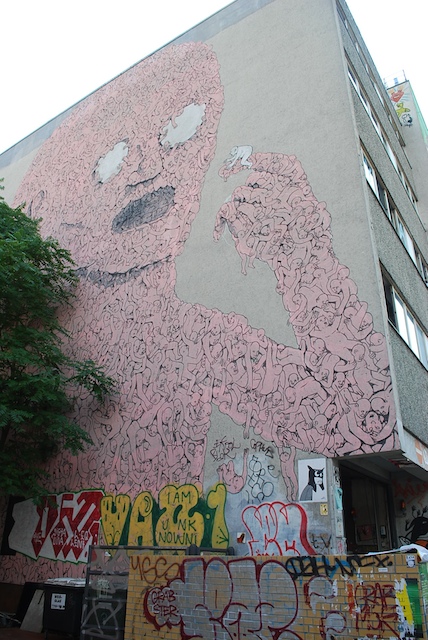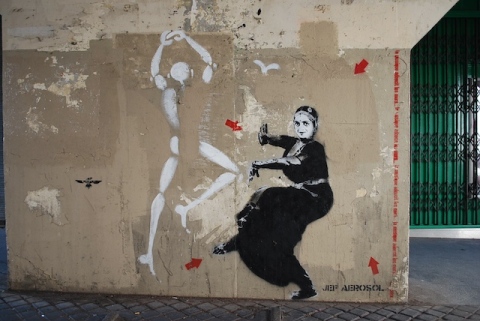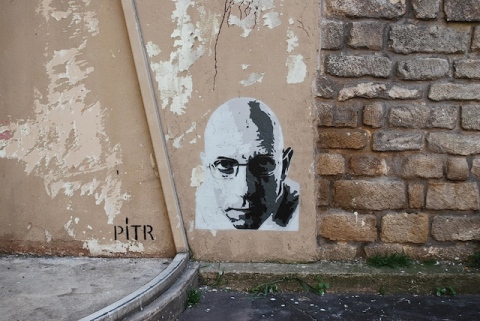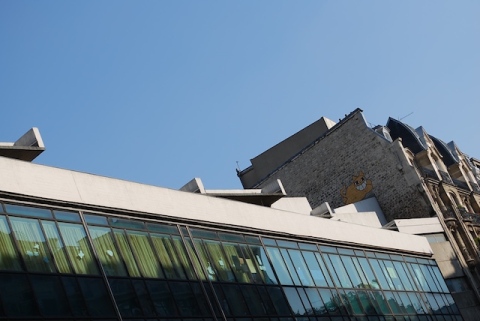Archive for the ‘graffiti’ Category
Old times, new times….
This site doesn’t normally do announcements about upcoming shows, as you will know if you have visited it before. But sometimes I like to put up information about a show that promises great things or is by artists who are really significant in the scene. Here’s some info about a show that starts May 16th that will deliver or both fronts.
If, like me, you have been following the graffiti and street art scenes in Melbourne for a long time, you will be thrilled to hear about an upcoming exhibition that celebrates the history and longevity of some of Melbourne’s most significant artists of the last decade – Ha-Ha, Sync and DLux. These were the names that helped to put Melbourne on the global map of significant street art centres. All three are still in the art game, and it’s fantastic that there is a show celebrating both the old times, and the new times, for these artists – and for Melbourne’s art.
End of radio silence!
Another long gap between posts…
I have been writing and editing and re-editing my book on street art, law and the city, and, as I have mentioned before, whenever I am immersed in academic writing I find it hard to switch my brain into blogging mode.
I’ve also done a year’s teaching, compressed into the months between April and August.
And I’ve been travelling: I spent 3 months in London (with trips to Paris and Istanbul), and have been back to Berlin recently, and am currently in London. Much of this has involved fieldwork for further research – this time on the uptake of street art in cultural institutions, the art market, architecture, and so on. More on those issues later.
I’ll post some photos from recent trips soon.
In the meantime, here’s a link to my upcoming book, Street Art, Public City: Law, crime and the Urban Imagination.
http://www.taylorandfrancis.com/books/details/9780415538695/
The publisher, Routledge, like many academic publishers, is bringing out a hardback edition first, with a paperback to follow (in about 8 months). This is kind of frustrating for me, because hardbacks are expensive. So when you click on the link below you will see that the book is pretty pricey. If you feel inspired to order it, you can reduce this hefty price a little by entering the discount pre-order code LAW202013 at the checkout.
I’m excited to see it finally in print; if you read it, I hope you find it interesting.
R.I.P. Dick Nose
If you live in inner-city Melbourne, you’ll have grown accustomed over the last few years to seeing ‘Dick Nose’ or ‘DN’. These words and initials have been written repetitively, obsessively, on walls, door frames, tram stops, bins – any and every urban surface. Sometimes dozens or even hundreds would appear over the course of a night’s bombing.
A couple of weeks ago, the walls of Fitzroy were covered with the words ‘R.I.P. Dick Nose’, to mark the death of an individual who has, over the last few years, made such an impact on the surfaces of the city.
No doubt many did not appreciate his work. No doubt it’s possible to criticise the aesthetic of his tagging as lacking any skill, driven instead by the bomber’s desire for quantity over quality, acreage over calligraphy. No doubt many were irritated by his repeated writing on house walls and fences, causing residents who might not be fans of graffiti bombing to spend many hours painting out his work. Irrespective of such criticisms, Dick Nose was a distinctive part of inner-city Melbourne, marking the surfaces of the city in his own way: not a ‘pretty’ or easy to like part of ‘street art’, but a significant one nonetheless, and his death is a sad conclusion to one form of urban intervention.
Shout outs….
There’s a tradition among artists and graffiti writers of giving shout outs to other artists who are friends, crew members, or just people you admire – sometimes by listing their names along side a piece you have made, sometimes by incorporating references to their work into your own, sometimes by painting a tribute to them….
Although I’m posting this in January 2012, I actually wrote it in September last year, after spending several hours walking around the San Lorenzo area of Rome, with Alice Pasquini, a Roman artist who has been extremely active recently – you can see her work in Paris, Rome, Melbourne, London, to name just a few of the cities she has visited.
Alice was kind enough to walk around San Lorenzo with me, and to drive me to Ostiense to see a piece by Sten + Lex, and then to Trastevere where I would spend the rest of the day. Her generosity prompted me to write this post to say a huge ‘thank you’ to her, for hours of great company and conversation.
And it got me thinking about how, in this world of street art, people can be so generous with their time, their willingness meet up and to chat. For the last four years I’ve been researching the ways in which street art has emerged as a distinctive cultural practice in the last decade or so, and much of that research has involved talking with people about their involvement in street art, their passion for it, and their views of its history and its potential. I wanted, instead of writing a ‘best of 2011’ type post, to take the opportunity to thank people who have helped me with my research, by sharing their own love of street art, and thus helping me to think through the issues I’m interested in. From 2012 till 2015 I’ll be working on a new project (still to do with street art, but different issues) and writing up the research I’ve carried out over the last several years, so this seemed like a good moment to pause and thank everyone who helped me in so many different ways.
So this post is about giving shout outs to the great people I have met over the last several years. Some people have spent hours walking with me around a city, admiring its illicit artworks. Others have put me in touch with interesting people to talk to. Many people have given up their time to be interviewed, in person or by email. What follows is not a complete list, because I have a few more interviews to carry out, but as of January 10th 2012 I owe thanks to the following people, in many different ways.
In Melbourne: CDH, Tom Civil, Nick Ilton, Kaff-eine, Ghostpatrol, Meggs, Miso, Rone, Shinobi, Sparcs, The Doctor, Vexta.
In London or elsewhere in the UK: Acoris Andipa of Andipa Gallery, Cedar Lewisohn, Clare Long and friends (for much fun in Grottaglie), Deadly Knitshade of Knit the City, Dscreet of Burning Candy, Eine, Fiona and Paul from Elms Lesters Painting Rooms, Dora Dewsbury and Tristan Manco of Pictures on Walls, Pure Evil, Remi/Rough, Mike Snelle of Black Rat Projects, Mark Rigney, Slinkachu, Tony Taglianetti and Bryce Péricard of Brick Lane Gallery, RJ of Vandalog, Nick Walker, Angela Wright.
In New York, and elsewhere in the US: Garrison Buxton of Ad Hoc Art, Jaime Rojo and Steven Harrington of Brooklyn Street Art, Cake, Elbow-Toe, Jon Fekner, Ali and Ad of Factory Fresh, Ellis Gallagher, Logan Hicks, Russell Howze of Stencil Archive, Anthony Lister, Luna Park, Mare139, Momo, Jeff Newman, José Parlá, Marc and Sara Schiller of Wooster Collective, Jordan Seiler, Swoon, Hrag Vartanian, Peat Wollaeger.
In Paris: L’Atlas, Alexone, Blék le Rat, C215, Jean Faucheur, Thierry Froger, Adeline Jeudy, Patrice Lerouge, Samantha Longhi, Miss.Tic, Leanne Sacramone, Yz.
In Berlin: El Bocho, DcideNow, Disturbanity, Brad Downey, Emess at ATM Gallery, Ollie of Hatch Sticker Museum, Just, Ingo of Klub 7, Johann Lanzenauer of Circleculture, Jaybo Monk, Adrian Nabi, Pisa73, Aisha Ronniger, Tower, The Wa.
In Rome and elsewhere in Italy: Alice Pasquini, Luca Borriello, Christian Ruggiero, Angelo Milano (of the FAME Festival in Grottaglie).
In Amsterdam: Claudius, Erris of Graphic Surgery, Laser 3.14, Chaz of The London Police, Morko, Zedz.
A big shout out to all of you. Many thanks. You are all amazing.
The Underbelly Project
As is by now well known to almost everybody with an interest in street art (and to quite a few more besides), a massive art project was organised by two individuals in New York City, and carried out with the involvement of more than 100 different artists from a range of countries – The Underbelly Project.
News of Underbelly recently broke in the New York Times and the London Times , and it’s fair to say that there has been quite the media furore about it.
(For many Australian readers, it may come as both a relief and a surprise to learn that ‘Underbelly’ refers to something other than an initially interesting and then subsequently tacky TV show on Channel 9….)
Underbelly, as an art project, is one of great audacity. It displays the work of the 100-plus artists on walls around a disused subway station in New York City. Painting had to be done in secret, during the night, and at some risk to the participants. It involved months of planning, organisation and execution, including documenting the artwork through photography and film. Artists whose work is displayed include Faile, Anthony Lister, Swoon, Indigo, Logan Hicks, Dan Witz, Rone, Meggs, PAC, Stormie Mills, Remi/Rough, Elbow-toe, Roa, Imminent Disaster, Mark Jenkins, Sheone, Smith/Sane, Revok and many more. You can see some of the works on Vandalog among other sites.
In April this year, I spent a few weeks in New York City, and met up with one of the two people behind Underbelly. I watched as he scrolled through dozens of astonishing photographs on his computer, explaining how lights had to be brought into the pitch blackness of the tunnel both for the artists to work and for the documentation of the process to be possible. Once the final piece had been painted, he told me, the entrance to the platform would be sealed off, and the location would be kept secret, so that the art would remain, and the documentation would attest to its existence, but no-one would be able to sell the images or to destroy it (time and the inhospitably humid environment of the tunnel would do that).
Hearing this account and seeing the images, I was quite awestruck. The project is so huge – partly because of the number of artists involved, with many coming from overseas, so even simply the logistics of coordinating visits to the tunnel, and allocating space within it was a major undertaking. It is also huge in that its execution took place over several months, in which the project, its nature and location must have been one of the best kept secrets in street art.
I was also captivated by the idea of taking street art underground, to a location that intersects with the history of graffiti and subway writing. I listened to the account of how the project would be independent of the art market, with the works existing within the tunnel, unable to be sold off afterwards (something that sounded extremely compelling, given that even works placed on the street for public enjoyment have often been removed in order to be sold).
And I must admit what got me the most was the idea that the tunnel would be sealed and no-one would be able to get in to see the artworks. It did give me a slight pang to think that such amazing works would be hidden from all spectators, but that was far outweighed for me by the romance of the idea that the artists would make the works, underground, in secret, in a space that acknowledges street art’s debt to the cultures of subway writing, and then that space, with all its beautiful artworks, would be sealed….
The very motivation behind Underbelly was a romantic one, I think. The project was born in the shared appreciation of two individuals for the empty and forgotten spaces of the city. It remained true to that shared sensibility; and it did not warp into something commercial.
It was one of the most exciting initiatives that I have come across, in all the years I’ve been thinking and researching in this area.
It felt incredibly exciting to see the media coverage of the project, and to see photographs of the works published so that they could be seen by others.
And my admiration for its creators knows no bounds.
But over the last several days, it would seem that, amongst the admiration and appreciation that has been offered, there are those who see Underbelly differently. Some seem to see it as a challenge, as if the organisers are saying, ‘go on, try and find it, bet you can’t…’ (see here for a forum in which some discuss how to find the tunnel and their experience of being arrested in doing so). Others seem to see it as a provocation, as though its existence needs to be condemned: this includes, interestingly, both the police, who are basically stationed at the location at present and arresting anyone who enters it, and individuals who have reportedly entered the tunnel and trashed some of the works. Still others have criticised the project’s creators, accusing them of cashing in,by making a documentary film about the project (this seems like such a bizarre criticism, given that the organisers felt that a film would allow a wider audience to get access to works that would otherwise be hidden from view. Full disclosure: I was interviewed about the project for the film.).
So: is there no romance left in street art? Maybe cynicism has taken hold of many of these commentators and critics, but in my opinion, the very existence of The Underbelly Project is a testament to the fact that some people in the world of street art (from the organisers through the artists who took part to the bloggers who visited the site and kept its secrets) still believe there is a place for hopeless romance amid the commercial imperatives of the market.
‘Where is Mona? She’s long gone…’
So sings Nick Cave, in the opening line of the track ‘Fifteen Feet of Pure White Snow’ on No More Shall We Part.
And this line jumped into my head this morning when I walked down a street in Fitzroy to find the Graffiti Removal guys busily washing a wall that I had photographed and posted about only last night (see the previous entry).
One of my favourite recent works, which seems to be signed ‘Mona’, was being buffed.
So if you are walking through the streets of Fitzroy looking for the artworks of Mona, as far as this partoicular site is concerned, ‘she’s long gone’, and what’s left is this:
I guess this must be one of those issues of personal taste. All the other recently added works nearby seemed to be still there; it’s only the ones on this house that have been buffed. Did the residents ask the council to remove it? Or did the council decide that this house should be buffed and not the others? The latter seems unlikely so I’m assuming it’s been done at the residents’ request.
To my mind, this raises lots of interesting issues. In my view, the residents are completely entitled to remove the work if they wish. If an artist puts work up without permission, then there’s always the risk that the person living or working inside the property may not appreciate the art, and wishes to remove it. It’s like if you give someone what you think is a cool T shirt or interesting book for their birthday, but they then ask if they can exchange it for something else – maybe you wish they wouldn’t, but hey, people are entitled to some autonomy about what they read and wear. Same with street art, I guess. If you don’t like it, I guess you can remove it (although many wish that removal wouldn’t happen quite so often or quite so speedily).
But the problem is that what’s left here really don’t look great, and so this raises the question of the technologies of graffiti removal. It’s like painting out graffiti but leaving a mismatched square of paint that just looks odd, or blasting off bill posters and leaving tattered strands of paper hanging from the wall. All of these techniques seem to be acceptable to many people, so it makes me wonder how aesthetics are being operationalised, such that blurry lines of faded paint, tattered paper or sloppily rollered paint looks ‘OK’ to those making the decisions about removal (whether these are council workers or residents). Perhaps these individuals would say that the ultimate solution is for artists not to put up work in the first place, thus obviating the need for removal, in all its imperfections.
I don’t agree. I think that it would be far more useful to have a debate about the aesthetics of the street, in which the effects of removal can be compared to the process of leaving a piece to weather and fade, or in which people can learn to appreciate that some streets are going to be modified in various ways as part of the culture of an area or a city, and in which artists can learn what types of image will work best on different kinds of surface…. I’d like to take part in such a debate, and I think others would too.
ADDENDUM:
By coincidence, Art of the State has a post about some magical stuff being done in London by the Toasters, in which they adapt those painted-out shapes and make them into new pieces of art…
ADDENDUM 2: Take a look at the link in the comment by Seldom which follows this entry – there’s a really interesting essay by ESPO (Steve Powers) about the pointlessness of painting over graffiti.
Berlin’s visitors….
As I mentioned before, I’ve recently been visiting Berlin. Like many cities with a reputation for interesting street art, Berlin attracts a wide range of artists who pass through the city for a short time and leave their work on the walls. So I thought I’d put up a selection of images by people who, like me, have been visitors to Berlin.
In the first few days that I was there, I went to see the Kunsthaus Tacheles, a massive building famed for its history as a squat and now as a centre for creative activity (although to me its atmosphere of hippie-chic cool seemed a little contrived and also somewhat dated…). On its external wall there’s a huge work by one of my favourite French artists, Yz (also known as Open Your Eyes) – and above it is the tag of one of Melbourne’s most prolific graffers, Bones (whose tag, along with those of other members of the 70K crew, I saw all over Berlin):
Here’s a small cat by C215, almost hidden in a corner to the rear of the building currently occupied by Kunstlerhaus Bethanien.
Bethanien is inextricably associated with Backjumps, the creative venture of Adrian Nabi, who over several years produced magazines and curated exhibitions and cultural events in Berlin, involving artists who work in public space. Over the years, artists such as Swoon, the London Police, Nomad, Brad Downey, Dave the Chimp and many other exhibited in Berlin under the Backjumps aegis. Part of the Backjumps events involved the curation of walls around the Kreuzberg area of Berlin for the display of works which would remain after the events were over. Here are a couple of examples, one from os gemeos and one from the London Police:
The area of Friedrichshain is also well known for its art on the streets, and the warren of bars, warehouses and skate park on Revaler Strasse contains hundreds of pieces, some commissioned, some added spontaneously. Amid a riot of tags, stencil, paste-ups and pieces near the Cassiopeia skate park I found a piece by Orticanoodles, with – once again – a tag by Bones accompanying it:
The River Spree constitutes a boundary between Friedrichshain and Kreuzberg, and as you travel over the Oberbaumbrucke (a wonderfully gothic looking bridge), the landscape is dominated by a massive piece by Blu, one of a number he has done in the city. Here’s a close up of the work:
Roa, the Belgian artist who has been achieving a lot of well-deserved attention recently, was in Berlin while I was there, and produced some fantastic work, such as this:
I also saw some old pieces in Kreuzberg by the French artist Nelio, whose work I admire greatly for its beautiful placement within any particular space (and which I’ve written about previously on this blog, see here). Here’s one:
And on my last night in Berlin, as I walked down Danen Strasse in Prenzlauer Berg to go back to my apartment, I discovered that Nelio must have been visiting Berlin once again, since a new piece had appeared:
It was nice to think that the phenomenon of artists making visits to this amazing city and contributing to the flux of images in public space was continuing, even as I was about to leave….
Refiguring the Walls of Paris
Street art and graffiti, when spoken about by those who don’t enjoy the experience of discovering unauthorised art in city spaces, are sometimes said to deface the walls of the streets in which they are found. Calling it ‘defacement’ is a way of saying ‘damage to property’, of course, but interestingly, when street art’s detractors want to focus on the question of purely physical damage to property, they usually use the term ‘vandalism’. So the term ‘defacement’ seems to speak to something else, as though the walls of the city have an outward face, which has been altered, spoiled, or even destroyed by the artwork – literally de-faced. (There’ an excellent book on the concept of defacement by Michael Taussig, if you are interested in thinking more along these lines…)
Thinking of city walls in this way sounds odd, until we start thinking of how we are quite accustomed to speaking of the facade of a building, for example; both ‘facade’ and ‘face’ share the same root, from facia (face) in Latin.
On my way home from Paris to Melbourne, I was thinking about the term ‘defacement’ and how it gets used as a negative descriptor of street art and graffiti (well, it’s a long, long flight, you have many hours in which to ponder these things). If walls have faces that can be ‘damaged’, then that sets the street artwork up as operating as a form of disfigurement.
[If you don’t look at street art as a form of disfigurement, then of course the addition of artworks to the city walls by its artists can be construed in many, positive lights (as written about in previous posts on this blog): as a gift, as a contribution to the community, as a means of beautification of drab spaces, as a form of communication between the artist and other members of the community, and as a means of celebrating the city itself.]
It seemed particularly fitting to me to think through the idea of street art and graffiti as a form of defacement and disfigurement after having spent two weeks in Paris this May. I spent hours walking through the streets and saw some amazing and inspiring work. One of the things that was striking about it is the preponderance of figurative work: there are hundreds of portraits by dozens of artists adorning the walls of Paris, and here is a selection of some of the ones I enjoyed most.
Here’s a section of a large work by the Vancouver-based artist Indigo:
One of the curving black figures created by FKDL:
A beautifully placed image by C215:
The incomparable Miss.Tic, making stencils since the mid-1980s:
Two works, dancing together. The corps blanc, or white figure, is by Jerome Mesnager, the female figure is by Jef Aerosol, both also veterans of the French scene:
And here is one of Nemo’s typically segmented scenes, in which a dark silhouetted figure tumbles through various scenes against a backdrop of sandstone:
As a graduate student, much of my time was spent reading the work of the French philosopher and historian Michel Foucault (and since becoming an academic, a lot of my time is spent teaching his work too), so it was a great pleasure to come across his face on a number of walls, placed there by the stencil artist PITR:
And I was fortunate enough to catch some freshly painted stencil works by Jana und JS, stunning in their photorealistic detail:
Finally, a slightly different kind of portrait, that of the grinning yellow cat made famous by Monsieur Chat. These cats apparently bound across many of Paris’s rooftops, but I caught sight of only one. You can just see its Cheshire-cat happiness high above the street, beaming down at the passers-by:
It’s easy to find this kind of street art appealing: well-executed images in bright colours, skillfully applied in well thought-out spaces. What’s not to like? Who could call these images a disfigurement of the walls? But I think that what I saw in Paris was more than just a negation of the criticism of street art’s detractors. And so I’ll say this: instead of simply being not-disfigurements, these works actively re-figure the streets of Paris, opening for the passer-by moments of narrative and instances of beauty where previously none had existed.
 Leave a comment
Leave a comment